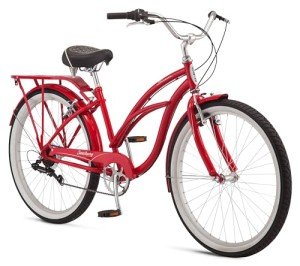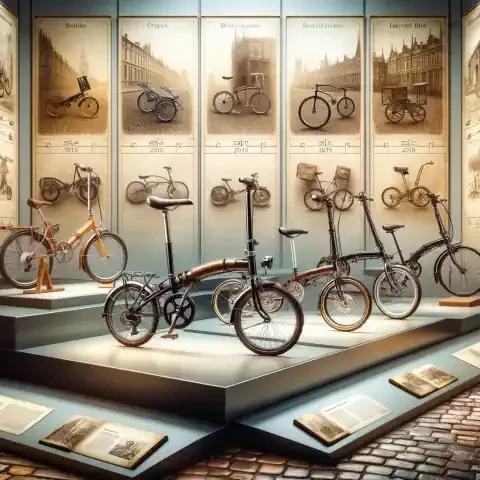Introduction
The Rise of an American Icon
Schwinn bicycles have etched a lasting mark on American cycling history, transcending their role as mere transportation to become an emblem of freedom, adventure, and nostalgia. Founded in Chicago in 1895, Schwinn quickly grew into a dominant force in the bicycle industry, captivating riders with innovative designs, quality craftsmanship, and a deep understanding of American culture. From its early days producing "World Bicycles" to its iconic models like the Sting-Ray and Varsity, Schwinn has continually pushed the boundaries of bicycle design, leaving an indelible mark on the way Americans ride and perceive bicycles.
A Legacy of Innovation and Design
Schwinn's commitment to innovation has been a driving force behind its success. The company consistently introduced groundbreaking features and technologies, shaping the evolution of bicycles and influencing the broader cycling industry. From the introduction of the balloon tire in the 1930s to the development of the first mass-produced BMX bike in the 1970s, Schwinn's relentless pursuit of improvement has set new standards for performance, comfort, and style.
Schwinn's Impact on American Culture
Schwinn bicycles have transcended their utilitarian purpose to become woven into the fabric of American culture. Their iconic designs and enduring popularity have made them a symbol of childhood, freedom, and adventure. From the beach cruisers gracing California's boardwalks to the rugged mountain bikes conquering challenging terrains, Schwinn bikes have become synonymous with the American spirit of exploration and self-expression.
Exploring Schwinn's Rich History
The story of Schwinn is a captivating tale of entrepreneurship, innovation, and resilience. From its humble beginnings in a small Chicago factory to its meteoric rise to prominence, Schwinn's journey reflects the changing landscape of American industry and consumer culture. By delving into the company's rich history, we gain a deeper appreciation for its contributions to cycling and its enduring impact on American society.
The Evolution of Schwinn Throughout the Years
Schwinn's evolution has been a fascinating journey, marked by both triumphs and challenges. The company has weathered economic downturns, technological shifts, and changing consumer preferences, adapting its strategies and product lines to remain relevant in an ever-evolving market. From its early focus on utilitarian bicycles to its later embrace of BMX, mountain biking, and electric bikes, Schwinn has consistently demonstrated a willingness to embrace new trends and technologies.
The Enduring Appeal of Schwinn Bicycles
Despite facing numerous obstacles throughout its history, Schwinn bicycles continue to hold a special place in the hearts of riders worldwide. Their timeless designs, nostalgic appeal, and reputation for quality craftsmanship have solidified their status as collectible classics and beloved everyday companions. Whether you're a seasoned cyclist or a casual rider, Schwinn bicycles offer a unique blend of history, style, and performance that continues to captivate generations of riders.
Schwinn Phocus 1400 Road Bike for Adults
The perfect choice for cycling enthusiasts, the Schwinn Phocus 1400 Road Bike for adults delivers unmatched performance and style
Product information
$595.98
Product Review Score
4.91 out of 5 stars
106 reviewsProduct links
The Early Years: Schwinn's Founding and Growth
Ignaz Schwinn: The Visionary Behind the Brand
The story of Schwinn begins with Ignaz Schwinn, a German-born mechanical engineer who immigrated to the United States in 1891. With a passion for bicycles and a keen eye for innovation, Schwinn quickly made his mark in the burgeoning American bicycle industry. His expertise in design and engineering laid the foundation for the Schwinn brand's reputation for quality and craftsmanship.
The Formation of Arnold, Schwinn & Company
In 1895, Ignaz Schwinn partnered with Adolph Arnold, a successful meatpacker, to establish Arnold, Schwinn & Company in Chicago. The company's initial focus was on producing bicycles for the rapidly growing American market, which was experiencing a bicycle craze at the time. Schwinn's designs quickly gained recognition for their quality and performance, propelling the company to early success.
Early Schwinn Models and Innovations
Schwinn's early models, such as the World Bicycle, showcased the company's commitment to innovation and quality. These bikes featured advanced features like internal hub gears, coaster brakes, and durable construction, setting them apart from competitors. Schwinn's relentless pursuit of improvement led to a series of groundbreaking innovations, including the introduction of the balloon tire in the 1930s, which revolutionized bicycle comfort and performance.
The Excelsior: Schwinn's First Major Success
The Excelsior, introduced in the early 1900s, became Schwinn's first major commercial success. This model, with its distinctive spring fork and elegant design, quickly gained popularity among riders of all ages. The Excelsior's success solidified Schwinn's reputation as a leading bicycle manufacturer and paved the way for future innovations.
Overcoming Challenges: The Great Depression and World War II
The Great Depression and World War II posed significant challenges for Schwinn and the entire bicycle industry. Despite these obstacles, Schwinn managed to survive and even thrive by adapting its production to meet the needs of the war effort. The company's expertise in manufacturing and engineering proved invaluable during this period, and Schwinn emerged from the war stronger and more resilient than ever.
Expanding the Market: The Rise of Bicycles for Leisure and Sport
In the post-war years, Schwinn recognized the growing demand for bicycles as a means of leisure and recreation. The company expanded its product line to include models specifically designed for casual riding, touring, and racing. Schwinn's marketing efforts, which emphasized the joy and freedom of cycling, helped to popularize bicycles as a form of leisure activity and fueled a boom in bicycle sales.
Schwinn's Reputation for Quality and Craftsmanship
Throughout its early years, Schwinn cultivated a reputation for producing high-quality bicycles with meticulous attention to detail. The company's commitment to using the finest materials and employing skilled craftsmen ensured that each Schwinn bicycle was built to last. This dedication to quality earned Schwinn a loyal following among riders who valued durability, performance, and style.
The Post-War Boom: Schwinn's Golden Age
The Bicycle Craze of the 1950s and 1960s
The post-war era ushered in a period of unprecedented prosperity and leisure time, sparking a nationwide bicycle craze. Americans, young and old, embraced cycling as a means of recreation, exercise, and transportation. Schwinn, with its reputation for quality and innovation, was perfectly positioned to capitalize on this surging demand. The company's models, ranging from classic cruisers to sporty road bikes, became synonymous with the carefree spirit of the times.
Iconic Schwinn Models: The Phantom, Sting-Ray, and Varsity
Schwinn's post-war lineup featured a series of iconic models that captured the imagination of riders and left an indelible mark on bicycle design. The Phantom, with its sleek lines and chrome accents, exuded an air of sophistication and adventure. The Sting-Ray, with its banana seat, high-rise handlebars, and slick rear tire, became a cultural phenomenon, symbolizing the rebellious spirit of youth. The Varsity, a versatile and durable model, became a favorite among college students and commuters.
Marketing Genius: Schwinn's Advertising Campaigns and Celebrity Endorsements
Schwinn's marketing prowess played a pivotal role in its success during the post-war boom. The company's advertising campaigns were innovative and captivating, featuring vibrant imagery, catchy slogans, and celebrity endorsements. Schwinn enlisted popular figures like Roy Rogers, Elvis Presley, and The Beach Boys to promote its bicycles, creating a sense of excitement and aspiration around the brand.
Schwinn's Dominance in the American Market
By the 1960s, Schwinn had established itself as the undisputed leader in the American bicycle market. The company's extensive dealer network, strong brand recognition, and diverse product line allowed it to capture a significant share of the market. Schwinn bicycles became a fixture in American households, and the company's influence extended beyond the cycling industry, shaping popular culture and inspiring generations of riders.
The Sting-Ray Phenomenon: A Cultural Icon Is Born
The Schwinn Sting-Ray, introduced in 1963, quickly became a cultural phenomenon. Its unique design, inspired by motorcycle aesthetics, resonated with young riders seeking a stylish and exciting way to express themselves. The Sting-Ray's popularity soared, fueled by a combination of clever marketing, celebrity endorsements, and its undeniable cool factor. The Sting-Ray's influence extended beyond the cycling world, inspiring trends in fashion, music, and popular culture.
The Expansion of Schwinn's Product Line
As Schwinn's popularity grew, so did its product line. The company expanded beyond its traditional offerings of cruisers and road bikes to include models designed for specific purposes and demographics. Schwinn introduced bicycles for children, women, and racing enthusiasts, catering to a diverse range of needs and preferences. This diversification of its product line allowed Schwinn to maintain its dominance in the market and appeal to a wider audience.
Innovation and Evolution: Schwinn Adapts to Changing Times
The Rise of Mountain Biking and BMX
The 1970s and 1980s marked a significant shift in the cycling landscape with the emergence of mountain biking and BMX. These new disciplines, characterized by their off-road capabilities and adrenaline-fueled stunts, quickly gained popularity among young riders seeking adventure and excitement. Schwinn, recognizing the potential of these growing trends, adapted its product line and marketing strategies to cater to the evolving demands of the market.
Schwinn's Response to the New Trends
Schwinn responded to the rise of mountain biking and BMX by introducing a series of innovative models designed specifically for these disciplines. The company's mountain bikes, such as the High Sierra and Sidewinder, featured sturdy frames, wide tires, and multiple gears, allowing riders to tackle challenging terrains with confidence. Schwinn's BMX bikes, like the Predator and Scrambler, boasted lightweight construction, responsive handling, and eye-catching designs, appealing to the younger generation's desire for speed and style.
The Impact of Foreign Competition
While Schwinn was adapting to new trends, it faced increasing competition from foreign bicycle manufacturers, particularly those from Japan and Taiwan. These companies offered lower-priced alternatives with comparable quality, putting pressure on Schwinn's market share and profitability. Schwinn struggled to compete on price, as its manufacturing costs were higher due to its commitment to using American-made components and labor.
The Introduction of Schwinn's Airdyne Exercise Bike
In an effort to diversify its product line and tap into the growing fitness market, Schwinn introduced the Airdyne exercise bike in the late 1970s. The Airdyne, with its unique fan-based resistance system and full-body workout capabilities, quickly became a popular choice for home fitness enthusiasts and professional athletes alike. The Airdyne's success demonstrated Schwinn's ability to innovate beyond traditional bicycles and cater to the evolving needs of consumers.
Schwinn's Continued Innovation in Design and Technology
Despite facing challenges from foreign competition, Schwinn continued to innovate in design and technology. The company experimented with new materials, such as aluminum and carbon fiber, to create lighter and more efficient bicycles. Schwinn also invested in research and development to improve suspension systems, braking mechanisms, and other components, pushing the boundaries of bicycle performance and ensuring its continued relevance in an ever-changing market.
The Challenges of the 1970s and 1980s
The Decline of American Manufacturing
The 1970s and 1980s witnessed a significant decline in American manufacturing, impacting industries across the board, including bicycle production. Factors such as rising labor costs, stricter environmental regulations, and increased competition from foreign manufacturers contributed to this decline. For Schwinn, this meant higher production costs and reduced competitiveness in the global market.
Increased Competition from Foreign Brands
As American manufacturing declined, foreign bicycle brands, particularly those from Japan and Taiwan, gained a foothold in the U.S. market. These brands offered lower-priced bicycles with comparable quality, appealing to price-conscious consumers. Schwinn, with its commitment to American-made components and higher labor costs, struggled to compete on price, leading to a decline in market share.
The BMX Craze: A Missed Opportunity?
The BMX craze of the late 1970s and early 1980s presented a significant opportunity for Schwinn to capture a new generation of riders. However, Schwinn's initial response to the BMX trend was slow and hesitant. The company underestimated the potential of BMX and failed to capitalize on its early popularity. By the time Schwinn introduced its own line of BMX bikes, the market had become saturated with competitors, making it difficult for the company to gain a foothold.
Labor Disputes and Financial Difficulties
Internal challenges further compounded Schwinn's difficulties during this period. The company faced a series of labor disputes, leading to strikes and production disruptions. These labor issues, combined with the rising costs of manufacturing and increased competition, put a strain on Schwinn's finances. The company's profitability declined, and it struggled to invest in new product development and marketing efforts.
The Sale of Schwinn to New Ownership
In 1992, facing mounting financial pressures, Schwinn was sold to a group of investors. The new owners implemented a series of cost-cutting measures, including moving production overseas and closing down several domestic factories. These changes helped to stabilize Schwinn's finances in the short term but further eroded the company's reputation for American-made quality and craftsmanship.
Attempts to Revitalize the Brand
Under new ownership, Schwinn attempted to revitalize the brand by introducing new models, expanding into new markets, and partnering with other companies. The company launched a line of electric bicycles, targeting the growing demand for eco-friendly transportation. Schwinn also partnered with retailers like Walmart and Target to expand its distribution network and reach a wider audience. However, these efforts were not enough to fully restore Schwinn's former glory.
The Schwinn Legacy: Enduring Popularity and Cultural Impact
Schwinn's Influence on Bicycle Design and Culture
Schwinn's impact on bicycle design and culture is undeniable. The company's innovations, such as the balloon tire, the cantilever frame, and the Sting-Ray's unique styling, have left a lasting mark on the industry. Schwinn's emphasis on quality, craftsmanship, and attention to detail set a benchmark for other manufacturers, elevating the standards of bicycle design and construction. Beyond its technical contributions, Schwinn also played a significant role in shaping bicycle culture, promoting cycling as a fun, healthy, and accessible activity for people of all ages and backgrounds.
Vintage Schwinn Bikes: Collectibles and Classics
Vintage Schwinn bicycles have become highly sought-after collectibles, cherished by enthusiasts and collectors alike. Models like the Black Phantom, the Sting-Ray Krates, and the Paramount are considered iconic classics, representing a bygone era of American cycling. These vintage bikes are not only valued for their historical significance but also for their timeless design, durable construction, and nostalgic appeal.
The Schwinn Brand Today: A New Era of Ownership
After a series of ownership changes and financial challenges, the Schwinn brand has found a new home under the Pacific Cycle group, a subsidiary of Dorel Industries. The company continues to produce a wide range of bicycles, from cruisers and commuters to mountain bikes and electric bikes. While Schwinn's manufacturing has largely shifted overseas, the company remains committed to innovation and quality, drawing inspiration from its rich heritage while embracing new technologies and trends.
The Continued Popularity of Schwinn Bicycles
Despite the challenges it has faced over the years, Schwinn bicycles continue to enjoy widespread popularity. The brand's strong name recognition, nostalgic appeal, and reputation for durability have ensured its continued relevance in the market. Schwinn bicycles can be found in bike shops, sporting goods stores, and online retailers across the country, catering to a diverse range of riders and needs.
Schwinn's Place in American Cycling History
Schwinn's place in American cycling history is firmly established. The company's contributions to bicycle design, manufacturing, and culture have shaped the way Americans ride and perceive bicycles. From its early days as a pioneer in the industry to its iconic models that defined generations, Schwinn's legacy is one of innovation, resilience, and enduring popularity. The Schwinn brand continues to evoke a sense of nostalgia and adventure, reminding us of a time when bicycles were not just a means of transportation but a symbol of freedom and possibility.
The Future of Schwinn: Looking Ahead
As Schwinn enters a new era under Pacific Cycle, the brand is poised for continued growth and innovation. The company is exploring new technologies, such as electric bikes and connected fitness solutions, to meet the evolving needs of modern riders. Schwinn is also investing in sustainability initiatives, aiming to reduce its environmental impact and promote responsible manufacturing practices. With a rich history and a commitment to innovation, Schwinn is well-positioned to remain a leading force in the cycling industry for years to come.
Schwinn's Impact on Popular Culture
Schwinn in Movies and Television
Schwinn bicycles have made memorable appearances in numerous movies and television shows, solidifying their place in popular culture. In the classic film "E.T. the Extra-Terrestrial," Elliot and his friends use their BMX bikes to escape government agents and help E.T. return home. The image of the children flying through the air on their Schwinn bikes, silhouetted against the moon, has become an iconic cinematic moment. In the coming-of-age film "The Sandlot," the characters' beloved Schwinn Sting-Rays are central to their summer adventures. The bikes represent freedom, friendship, and the carefree spirit of childhood. These are just a few examples of how Schwinn bicycles have been woven into the fabric of popular entertainment, captivating audiences and leaving a lasting impression.
The Sting-Ray's Influence on Music and Fashion
The Schwinn Sting-Ray, with its distinctive design and rebellious spirit, became a cultural phenomenon in the 1960s and 70s. The bike's influence extended beyond the cycling world, inspiring trends in music and fashion. The bike's unique styling, with its banana seat, high-rise handlebars, and colorful accessories, influenced fashion trends, with teenagers adopting a "Sting-Ray style" characterized by bell-bottom jeans, tie-dye shirts, and long hair.
Schwinn's Presence in Advertising and Art
Schwinn's marketing and advertising campaigns have been consistently innovative and memorable. The company's iconic ads, featuring vibrant imagery, catchy slogans, and celebrity endorsements, have become part of American pop culture. Schwinn's marketing efforts have not only promoted the brand but also contributed to the broader cultural conversation around cycling, adventure, and freedom. Additionally, Schwinn bicycles have been featured in works of art, including paintings, sculptures, and photography, further solidifying their status as cultural artifacts.
The Schwinn Lifestyle: Freedom, Adventure, and Nostalgia
Schwinn bicycles evoke a sense of freedom, adventure, and nostalgia. They represent a simpler time when bicycles were not just a means of transportation but a gateway to exploration and self-expression. The Schwinn lifestyle is one of carefree rides along the beach, exhilarating downhill runs, and childhood memories of cruising around the neighborhood with friends. It's a lifestyle that celebrates the joy of cycling and the sense of community that it fosters.
Celebrity Schwinn Enthusiasts
Throughout its history, Schwinn has attracted a loyal following of celebrity enthusiasts. Actors, musicians, athletes, and other notable figures have embraced the brand, riding Schwinn bikes both on and off-screen. From Elvis Presley to Arnold Schwarzenegger, these celebrity endorsements have further elevated Schwinn's status as a cultural icon and reinforced its association with a fun-loving, adventurous spirit.
Schwinn's Role in Shaping American Culture
Schwinn's impact on American culture extends far beyond its bicycles. The company's marketing campaigns, iconic designs, and celebrity endorsements have all contributed to shaping the way Americans view and interact with bicycles. Schwinn has helped to popularize cycling as a recreational activity, a means of transportation, and a symbol of freedom and individuality. The brand's enduring legacy continues to inspire generations of riders, reminding us of the joy and adventure that can be found on two wheels.
Collecting and Restoring Schwinn Bicycles
The Popularity of Vintage Schwinn Bikes
Vintage Schwinn bicycles have experienced a surge in popularity in recent years, captivating collectors and enthusiasts alike. Their timeless designs, nostalgic appeal, and enduring quality have made them sought-after treasures. Whether it's the iconic Sting-Ray, the sleek Varsity, or the classic Black Phantom, vintage Schwinns represent a bygone era of American cycling and hold a special place in the hearts of many.
Identifying and Authenticating Schwinn Models
With the rise in popularity of vintage Schwinn bikes, it's essential to be able to identify and authenticate different models. Collectors often rely on serial numbers, decals, and other unique features to determine the year and model of a Schwinn bicycle. Online resources, such as Schwinn forums and dedicated websites, provide valuable information and tools for identifying and authenticating vintage bikes.
Tips for Restoring and Maintaining Schwinn Bicycles
Restoring a vintage Schwinn bicycle can be a rewarding and enjoyable experience. It involves meticulous attention to detail, knowledge of the bike's original components and specifications, and a passion for preserving a piece of cycling history. Online resources and communities offer a wealth of information and guidance on restoring Schwinn bikes, from sourcing original parts to mastering the intricacies of paint and decal restoration. Proper maintenance is also crucial to ensure that these vintage bikes continue to function smoothly and retain their value.
The Schwinn Community: Enthusiasts and Collectors
The Schwinn community is a vibrant and passionate group of enthusiasts and collectors who share a common love for these iconic bicycles. Online forums, social media groups, and local clubs provide a platform for Schwinn owners to connect, exchange information, and showcase their restorations. The Schwinn community is a valuable resource for anyone interested in learning more about these bikes, finding rare parts, or simply sharing their passion for Schwinn bicycles.
Resources for Schwinn Collectors
Numerous resources are available for Schwinn collectors, ranging from online forums and websites to specialized books and publications. These resources provide valuable information on identifying, authenticating, and restoring Schwinn bicycles. They also offer insights into the history of the brand, the evolution of its models, and the cultural significance of Schwinn bikes. For those looking to expand their collection or connect with fellow enthusiasts, these resources are an invaluable tool.
The Joy of Owning and Riding a Piece of History
Owning and riding a vintage Schwinn bicycle is a unique experience that connects riders to a rich history and a vibrant community. These bikes represent a bygone era of American craftsmanship and design, and riding one is a way to relive those nostalgic memories and experience the joy of cycling as it was intended. Whether cruising down a quiet street or tackling a challenging trail, vintage Schwinn bikes offer a unique blend of style, performance, and historical significance that continues to captivate riders today.
Conclusion
The Enduring Legacy of Schwinn Bicycles
Schwinn bicycles have left an enduring legacy in the annals of American cycling history. From their humble beginnings in a Chicago factory to their iconic status as symbols of freedom, adventure, and nostalgia, Schwinn bikes have captured the hearts and imaginations of generations of riders. The brand's commitment to innovation, quality, and craftsmanship has set a benchmark for the industry, inspiring countless other manufacturers and shaping the evolution of bicycle design.
Schwinn's Contribution to American Cycling
Schwinn's contribution to American cycling extends far beyond its bicycles. The company's marketing campaigns, celebrity endorsements, and cultural impact have helped to popularize cycling as a recreational activity, a means of transportation, and a symbol of American ingenuity and spirit. Schwinn's advocacy for cycling safety and education has also played a crucial role in promoting responsible ridership and ensuring the continued growth of the sport.
The Future of the Schwinn Brand
Under the ownership of Pacific Cycle, the Schwinn brand continues to evolve and adapt to the changing needs of modern riders. The company is investing in new technologies, such as electric bikes and connected fitness solutions, to meet the demands of a more environmentally conscious and health-conscious consumer base. Schwinn is also expanding its product line to cater to a wider range of riders, from casual cruisers to competitive cyclists. With a focus on innovation, quality, and sustainability, Schwinn is well-positioned to continue its legacy as a leading force in the cycling industry.
Celebrating a Century of Innovation and Design
As Schwinn approaches its 130th anniversary, it is a time to celebrate the company's rich history of innovation and design. From the early days of the Excelsior to the iconic Sting-Ray and beyond, Schwinn has consistently pushed the boundaries of what is possible on two wheels. The company's commitment to quality craftsmanship, cutting-edge technology, and timeless design has earned it a place among the most respected and beloved bicycle brands in the world.
Schwinn: An American Icon
Schwinn bicycles are more than just bikes; they are an American icon. They represent a spirit of adventure, freedom, and individuality that resonates with people of all ages and backgrounds. From childhood memories of learning to ride a bike to the thrill of conquering a challenging trail, Schwinn bikes have been a part of countless American stories. As we look to the future, the Schwinn brand continues to inspire and empower riders, reminding us that the journey is just as important as the destination.
Summary
Schwinn bicycles, an American icon, have shaped the landscape of cycling for over a century. Founded in 1895 by Ignaz Schwinn, the company quickly established itself as a leader in innovation and design, producing high-quality bikes that resonated with American consumers. From its early successes with models like the Excelsior to the post-war boom fueled by the iconic Sting-Ray and Varsity, Schwinn bikes became synonymous with freedom, adventure, and Americana.
Throughout its history, Schwinn faced numerous challenges, including the rise of foreign competition, labor disputes, and financial difficulties. Despite these obstacles, the company continued to innovate, adapting to changing market trends and consumer preferences. While Schwinn experienced periods of decline, its enduring legacy is evident in its continued popularity among collectors and enthusiasts, its influence on bicycle design and culture, and its presence in popular media.
Today, Schwinn remains a prominent brand in the cycling industry, producing a diverse range of bicycles for all types of riders. The company's commitment to quality, innovation, and sustainability ensures that it will continue to shape the future of cycling, while its iconic models and rich history will forever remain a cherished part of American culture.







